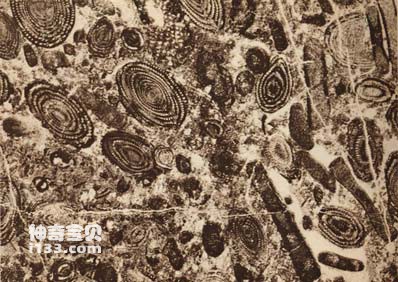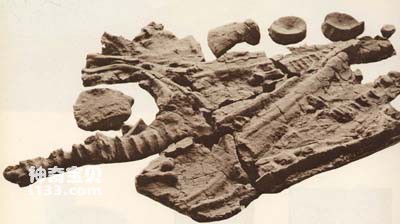During the Pliocene Epoch, the average altitude of the Qinghai-Tibet Plateau was only a few hundred meters to about 1,000 meters. Scientists have accumulated extremely thick river and lake facies at an altitude of more than 4,000 meters in the Gyirong Basin on the north side of Shishapangma Peak, which is 8012 meters above sea level. , found fossils of the three-toed horse fauna that lived 10 million to 3 million years ago.

Marine invertebrate fossils from about 40 million to 100 million years ago
The three-toed horse is the ancestor of modern horses. It is smaller and has three toes on its hooves. During the Pliocene Epoch, it lived in low-lying tropical and subtropical forest steppes and savannas. It is extremely widely distributed and has its footprints in Eurasia, North America and Africa, so it is a typical animal of the Pliocene Epoch. The animals that coexist with it include rhinos, giraffes, antelopes, bamboo rats, etc., collectively known as the three-toed horse fauna. Fossils of the three-toed horse fauna are very common in the Pliocene strata in North my country, Northwest China, and northern India. What is intriguing is that, except for the Qinghai-Tibet Plateau, the altitude of all these fossil sites is only a few hundred meters, no more than about a millimeter at most. This shows that the places where the three-toed horse fauna lived at that time had relatively low terrain and a relatively warm and humid climate.

Fossils of Tibetan Himalayan ichthyosaurs, a marine animal dating back approximately 180 million years
In the past, no three-toed horse fossils were found on the Qinghai-Tibet Plateau, which was often used as counter-evidence that the Great Plateau has existed since ancient times. It is believed that the migration route of the three-toed horse from China to South Asia was through Afghanistan, Iran and then to Pakistan and India. Nowadays, many three-toed horse animal fossil sites have been found not only in the Jilong Basin on the plateau, but also in Nyalam, Zhada, and other places. The altitude of these places is more than 4,000 meters, the average annual temperature is below 1°C, and the annual precipitation is about 400 mm. Obviously, the three-toed horse cannot live in this climate. This proves that until the Pliocene period, today's plateau was still not high and did not constitute an obstacle to the free movement of the three-toed horse fauna.
It can be said that the era when the three-toed horse fauna lived was a prosperous period in the geological history of the plateau. This period was a stable stage after the Tethys Sea retreated and closed into land. The crustal movement was not strong, the mountains were eroded and reduced, and a large amount of material was transported and accumulated into basins and valleys. The sediments are hundreds of meters thick. The entire plateau area is characterized by a vast quasi-plain landform. There are no steep cliffs or deep canyons. There are large and small lakes scattered on the slightly undulating plains. The lakes in northern Tibet are wide and deep. Fish are swimming in the water and birds are playing on the lakeside.

Restoration map of Himalayan ichthyosaur fossils
In the fault depression zone of southern Tibet and the northern foot of the Himalayas, lakes are distributed in strips, like silver beads, making southern Tibet very beautiful. Although the Gangdise Mountains, Tanggula Mountains, Kunlun Mountains and other mountains already existed at that time, they were not very high, and the average height of the Himalayas was less than 3,000 meters. The climate is humid in winter and warm in summer. The average annual temperature difference between the north and the south is only about 6°C. In this relatively uniform climate environment, the three-toed horse fauna has become the dominant species. The humid and warm climate caused the soil to develop a red color, and this layer of red weathering crust can be seen in many places today.
The discovery of the fossils of the three-toed horse fauna provides us with inspiration for studying the restoration of the Pliocene paleogeographic environment of the Qinghai-Tibet Plateau. Their extinction reflects that geological history has entered a new stage, that is, the strong uplift of the earth's crust gradually formed today's Tibetan Plateau.
We created this article in conjunction with AI technology, then made sure it was fact-checked and edited by a Animals Top editor.